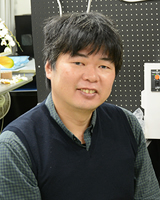
ここからコンテンツです。

Making bio-gas power generation more accessible towards a carbon-free and recycling-oriented society
Yoichi Atsuta
Renewable energy sources are increasingly being introduced as a means to achieve carbon neutrality. Among them, biomass energy sources are able to contribute to a carbon-free society and the effective use of waste, an issue that is attracting public attention. Toyohashi Biomass Solutions is involved in the bio-gas power generation-related business using waste biomass. They are working to ubiquitize bio-gas power generation through the development of ultra small plants, new technologies that improve the profitability of the power generation business, consulting with people about the introduction of biomass solutions, and other activities. We interviewed Yoichi Atsuta, the president of the company, about the key points of their technology and the society they aspire to establish.
Interviews and report by Akiko Seki
Harness the wind blowing toward bio-gas power generation
Biomass is used to refer to renewable biological organic materials that are not fossil resources. Biomass power generation is positioned as a renewable energy. It is generated by the direct combustion or gasification of wood biomass or by using bio-gas extracted from waste biomass such as livestock excrement, food waste, and sewage sludge through methane fermentation and other means. Dr. Atsuta established Toyohashi Biomass Solutions in May 2021 to operationalize bio-gas power generation plants, related technologies, and introduction consultations for bio-gas power generation methods. Dr. Atsuta told us that he decided to start the business because of changing social trends.
"Since around last year, the move toward carbon neutrality has been gaining momentum in Japan. This is a tailwind for bio-gas power generation, and I think now is the right time to introduce our unique plant to the world.
Dr. Atsuta is a visiting associate professor of Toyohashi University of Technology's Bio Research Center. The company, which was established on the premises of the university, is certified as a venture originating from Toyohashi University of Technology.
Methane fermentation (anaerobic digestion) is a collective name for the reaction processes in which methanogenic bacteria or other microbial communities decompose organic matter in anaerobic conditions to generate methane and CO2.
"Bio-gas power generation uses this process to extract bio-gasses including methane from livestock excrement, food waste, etc. to burn the gas in a gas engine. In addition to using waste as an energy source, it can also use the digested fluids after methane fermentation as liquid fertilizer because it contains a lot of nitrogen, potassium, and other nutrients. Returning it to agricultural land will lead to the creation of a resource-circulating society."
Because of these characteristics, bio-gas power generation has been widely adopted in Europe, where ecological awareness is high and there are active agriculture and livestock industries. However, it has not achieved great popularity in Japan because it requires a complicated system, expertise, and an initial investment. Plant facilities are mainly imported from Europe, and they are too big for agriculture and livestock operators in Japan, most of whom are running small operations. These problems must be resolved if bio-gas power generation is to become ubiquitous.
The development of new technology leading to ubiquitization
Dr. Atsuta has been very interested in environmental issues since he was a student. He began researching methane fermentation technologies after he took part in a bio-gas power generation demonstration experiment at a sewage treatment facility in Toyohashi-city when he was a researcher at Toyohashi University of Technology. When Dr. Atsuta was researching bio-gas power generation, he felt the need to resolve the problems in bio-gas power generation and launched a consortium with GENECH, etc., which he had become familiar with during the demonstration experiment. They jointly developed a small bio-gas power generation plant with a generation capacity of 20 to 30 kW, which is approximately one tenth that of conventional plants, and began selling it in 2016. The plants, which are called Toyohashi-model bio-gas power generation systems, have begun operating at six locations to date.
Dr. Atsuta has also worked on the development of new technologies. One such technology is an ammonia removal and collection system. During a reaction during methane fermentation, nitrogen and hydrogen bind together to generate ammonia. While ammonia is essential for methane fermentation, it inhibits fermentation when the raw materials contain a lot of nitrogen, which causes the ammonia concentration to be too high. Consequently, Dr. Atsuta developed a technology that volatilizes ammonia to remove and collect it and is now performing demonstration experiments. "Once this technology is put into practical use, it will be possible to use chicken droppings and other excrement that contains a lot of nitrogen to generate power, which means that the number of use-cases for bio-gas power generation will expand," Dr. Atsuta explained.
Another technology is the practical application of plants that are even smaller than the Toyohashi model. "The Toyohashi model is small, but it is still capable of processing 10 tons of biomass per day and includes a reinforced concrete fermenter. Many food factories and other facilities generate only approximately 1 to 2 tons of waste per day, so it is difficult for them to introduce the system unless the fermenter is made smaller. Because the fermenter is made of reinforced concrete, which requires construction, there is a loss of profitability as the size decreases, so together with Lemming Corp., we employed a general-purpose tank made of FRP as a fermenter and developed a plant that can be installed at a low cost"
Toyohashi Biomass Solutions provides these ultra-small plants to its customers. When customers require larger plants, they provide services in cooperation with the companies in the consortium.
Supporting the power generation gusiness using university-originated technologies and consultation
Toyohashi Biomass Solutions also developed an auxiliary agent for methane fermentation, as well as a quality control method for it, jointly with Komasuya Ltd. The auxiliary agent is generated through the lactate fermentation of food waste. Inputting an appropriate amount of the agent into a methane fermenter cab lowers pH, reduces the amount of ammonia that is generated, and increases the amount of bio-gas that is generated.
"Because bio-gas power generation is included in the FIT (feed-in tariff) targets, an increased volume of gas generated will increase the amount of power generated and purchased, which leads to the improvement of profitability"
One reason why bio-gas power generation has not caught on is that an advanced evaluation of its profitability is difficult because the volume of gas generated varies depending on the type of waste used as the raw material and other conditions. Dr. Atsuta performed fermentation tests with actually used raw materials and helps customers plan their business based on the bio-gas generation volume forecasts and consultations regarding compliance with laws and other regulations.
The lifecycle of a power generation business is calculated in units of 10 or 20 years. Dr. Atsuta also explained that he was operating his business from a long-term perspective.
"By accumulating best practices through the support of both hardware and software, including university-originated technologies based on scientific knowledge and consultations, I want to increase the accessibility of bio-gas power generation. I will develop a cycle for regional resource recirculation in cooperation with people in an array of industries, with the goal of achieving a society that produces less waste"
Reference
Dr. Atsuta's message to people who wish to start their own business
The important thing is to build connections with people. I would suggest that you connect with a wide range of people in government, industry, and academia. I have worked for a long time with a view toward starting my own business. However, I noticed that there were a lot of things I did not see because I was focused on getting it up and running. It was a long time before I started to feel that I was able to handle my business. However, because of that, I started my business at the best time. Even if you are ultimately unable to start your own business, I believe the experience will help you in the future.
脱炭素・循環型社会へ、バイオガス発電をもっと身近に
熱田 洋一
カーボンニュートラルの実現に向け、導入が進む再生可能エネルギー。なかでも脱炭素に加えて廃棄物の有効活用にも寄与できるバイオマスエネルギーへの関心が高まっている。株式会社豊橋バイオマスソリューションズは、廃棄物系バイオマスを利用したバイオガス発電の関連事業を手がける。プラントの超小型化、発電事業の採算性を高める新技術、導入コンサルティングなどにより、バイオガス発電の普及に取り組む。同社の代表取締役、熱田洋一さんに技術のポイントとめざす社会像について聞いた。
バイオガス発電への追い風をつかむ
「バイオマス」とは、生物に由来する再生可能な有機性資源から化石資源を除いたものを指す。バイオマス発電は再生可能エネルギーとして位置づけられ、木質系バイオマスの直接燃焼あるいはガス化による発電のほか、家畜排泄物・食品廃棄物・下水汚泥などの廃棄物系バイオマスからメタン発酵で取り出したバイオガスによる発電などが行われている。後者のバイオガス発電のプラントと関連技術、導入コンサルティングを事業化するため、熱田さんは2021年5月に株式会社豊橋バイオマスソリューションズを設立。起業を決断した背景には社会的な潮流の変化がある、と熱田さんは語る。
「昨年あたりから国内でもカーボンニュートラルの実現に向けた動きが本格化しています。これはバイオガス発電にとっては追い風で、当社独自のプラントを世に送り出すには今が最適なタイミングだと思いました」。熱田さんは豊橋技術科学大学先端農業・バイオリサーチセンターの客員准教授であり、大学内に設立した同社は豊橋技術科学大学発ベンチャーに認定されている。
メタン発酵(嫌気性消化)は、メタン生成細菌をはじめとする微生物群集が嫌気条件下で有機物を分解し、メタンと二酸化炭素を発生させる反応プロセスの総称である。「バイオガス発電では、このプロセスを利用して家畜排泄物や食品廃棄物などからメタンガスを含むバイオガスを取り出し、ガスエンジンで燃焼させて発電します。廃棄物をエネルギー源として活用できるだけでなく、発酵後に残るメタン発酵消化液は窒素やカリウムなどを多く含むことから液肥としても利用でき、農地還元すれば循環型社会の構築につながります」
こうした特徴から、バイオガス発電は環境意識が高く農畜産業が盛んな欧州で広く普及してきた。ただ仕組みが複雑で専門知識が求められ、初期費用もかかることから、国内ではあまり普及してこなかった。プラント設備は欧州からの輸入品が主流で、小規模経営が大半を占める国内の農畜産事業者では規模が大きすぎて適用しにくい。バイオガス発電の普及には、これらの課題解決が必要だった。
普及につながる新技術の開発
学生時代から環境問題への関心が高かった熱田さんは、豊橋技術科学大学の研究員として、豊橋市の下水処理施設で行われたバイオガス発電の実証実験に参加したことがきっかけでメタン発酵技術の研究を始める。研究のなかでバイオガス発電の課題に取り組む必要性を感じ、実証実験で知り合ったゼネック株式会社らとコンソーシアムを立ち上げた。そして発電容量が20~30kWと従来の10分の1程度の小型バイオガス発電プラントを共同開発し、2016年から提供を開始。「豊橋式バイオガス発電システム」と呼ばれるこのプラントは、現在までに6か所が稼動している。
一方、新しい技術の開発にも取り組んできた。一つは、アンモニアの除去・回収システムである。メタン発酵では反応の過程で窒素と水素が結合し、アンモニアが発生する。アンモニアはメタン発酵に欠かせないが、原料中の窒素が多いと濃度が高くなりすぎ、発酵を阻害してしまう。そこで熱田さんはアンモニアを揮発させて除去・回収する技術を開発し、実証実験を進めている。「この技術が実用化できれば、窒素含有量の多い鶏糞などもバイオガス発電に利用できるようになり、適用範囲が広がります」 と熱田さんは展望を語る。
二つめは豊橋式よりもさらに小さい超小型プラントの実用化だ。「豊橋式も小型とはいえ、1日に10tのバイオマスを処理できる規模で、発酵槽は鉄筋コンクリート製です。食品工場などの多くは1日の廃棄物が1~2t程度ですから、発酵槽をさらに小型化しないと導入しにくい。その規模だと土木工事が必要な鉄筋コンクリート製では採算がとれなくなるため、汎用のFRP製タンクを発酵槽に応用し、低コストで設置できるプラントを株式会社レミングと共同開発しました」
豊橋バイオマスソリューションズが提供するのは、この超小型プラントだ。より大きなプラントが求められるケースでは、コンソーシアムの企業と連携して対応している。
大学発の技術とコンサルティングで発電事業を支援
さらに、メタン発酵助剤とその品質管理方法を株式会社小桝屋と共同開発した。助剤は食品廃棄物を乳酸発酵させたもので、適切な量をメタン発酵槽に投入すると、pHを下げてアンモニアの発生を抑え、バイオガスの発生量を増やす効果がある。
「バイオガス発電はFIT(固定価格買取)制度の対象ですから、ガスの発生量が増えると発電量、ひいては買取量が増え、採算性の向上につながります」
これまでバイオガス発電が普及しなかった要因には、原料となる廃棄物の種類や条件によってガスの発生量が異なり、採算性の事前評価が難しいことも挙げられる。熱田さんは実際に使用する原料で発酵試験を行い、バイオガス発生量の予測に基づいた事業計画の立案や、法規制への対応などのコンサルティングも手がける。
発電事業は10年、20年単位の計画で進めていくものであり、熱田さんも長期的なビジョンでみずからの事業に取り組んでいると語る。「科学的な知見に基づいた大学発の技術とコンサルティングというハードとソフト両面からの支援により、成功事例を積み上げていくことでバイオガス発電を身近にしたい。廃棄物として捨てるものがより少ない社会をめざして、異業種の方々とも連携しながら地域における資源循環の輪を育てていきます」
(取材・文=関 亜希子)
熱田さんから起業を志す皆さんへメッセージ
大切なのは、人とのつながりを充実させることです。産学官や多業種、幅広い分野の人とのつながりをつくっておくことをお勧めします。私は長年、起業することを視野に入れて活動をしてきましたが、起業を意識することで、かえって今まで見えていなかったことが多くあることに気づき、「今なら、会社経営が成り立つだろう」と思えるようになるのに時間がかかりました。しかし、それによって最適なタイミングで起業することができたと感じています。最終的に起業できなかったとしても、そうした経験はあとで必ず役立つのではないでしょうか。
Researcher Profile

| Name | Yoichi Atsuta |
|---|---|
| Affiliation | Toyohashi University of Technology (TUT) and Toyohashi Biomass Solutions, Co. Ltd. |
| Title | Visiting associate professor of TUT CEO of Toyohashi Biomass Solutions |
| Field of Business | Material Cycles and Waste Management/ Environmental Science/ Anaerobic Digestion |
Reporter Profile

Akiko Seki is a freelance writer. She graduated from Department of Applied Biological Science, Faculty of Agriculture at Tokyo University of Agriculture and Technology. She has worked on technical journals for major companies and has served reporting and writing in the field of science and technology.
ここでコンテンツ終わりです。
